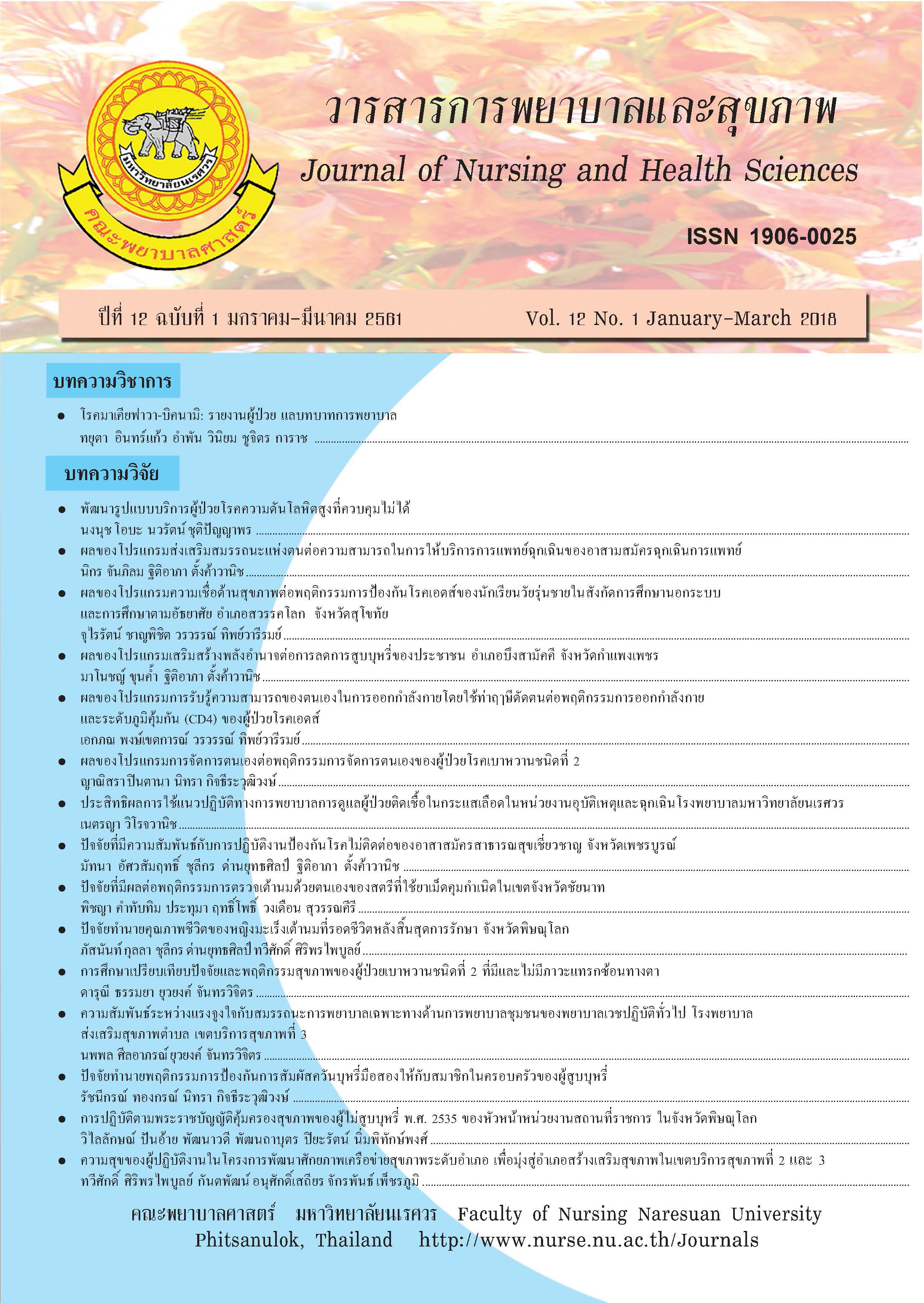Effects of Health Belief Program on AIDS Prevention Behaviors among Male Adolescents of Non-formal and Informal Education, Sawankhalok, Sukhothai
Main Article Content
Abstract
The objectives of this repeated measure, quasi-experimental research was to examine the effects of health belief program on AIDS preventive behaviors among male adolescents of Sawankhalok District Non-formal and Informal Education Center, Sukhothai province. Samples were 60 male adolescents aged between 16 - 18 years old. Purposive sampling method was used to recruit the participants who were assigned into the experimental and control group, with 30 participants each group. Data were analyzed using descriptive statistics and repeated measure ANOVA. The results of the study revealed the followings: 1) In the experimental group after participation in the program, mean scores of knowledge, attitude, AIDS preventive behaviors in terms of condom used during sexual intercourse were statistically significant higher than before participation (p < .001). Mean scores of no multiple sexual partners, no alcohol drink and addictive substance use before sexual intercourse, and not buying sexual services were statistically significant higher than before participation (p < .05). 2) Comparison between experimental group and control group, mean scores of knowledge regarding AIDS and prevention and no multiple sexual partners among male adolescents of the experimental group were statistically significant higher than the control group (p < .05), mean scores of attitude towards AIDS, no alcohol drink and addictive substance use before sexual intercourse, and not buying sexual services of the experimental group was statistically significant higher than the control group (p < .001). The findings of this study indicated that the Health Belief Program could be used as a strategy to promote AIDS preventive behaviors among male adolescents.
Article Details
References
พฤติกรรมที่สัมพันธ์กับการติดเชื้อเอชไอวี
ใน 9 กลุ่ม ประชากรเป้าหมายพื้นที่กรุงเทพ
มหานคร ปี 2558. นครปฐม:สถาบันพัฒนา
สุขภาพอาเซียน มหาวิทยาลัยมหิดล.
จรรยา เศรษฐพงศ์, เกียรติกำจร กุศล, สายฝน เอกวรางกูร
และปิยธิดา จุลละเปีย. (2550). พฤติกรรมเสี่ยง
ต่อสุขภาพของวัยรุ่นในสถานศึกษาจังหวัด
นครศรีธรรมราช.วารสารการพยาบาลและ
การศึกษา สถาบันพระบรมราชชนก. 3(3), 51-63.
เจตนิพิฐ สมมาตย์. (2557). ผลของโปรแกรมการให้
ความรู้เกี่ยวกับโรคเอดส์ตามแบบแผนความ
เชื่อด้านสุขภาพในนักเรียนชั้นมัธยมศึกษา
ตอนต้น จังหวัดขอนแก่น (พิมพ์ครั้งที่ 1).
ขอนแก่น: วิทยาลัยการสาธารณสุขสิรินธร.
เจียรนัย ทรงชัยกุล. (2554). เอกสารการสอนชุดวิชา
จิตวิทยาและวิทยาการการเรียนรู้ (พิมพ์ครั้งที่ 2).
กรุงเทพฯ:โรงพิมพ์มหาวิทยาลัยสุโขทัย
ธรรมาธิราช.
ชุตินธร จังสถิตย์กุล. (2553). ผลของโปรแกรมสุขศึกษา
ในการประยุกต์แบบแผนความเชื่อด้านสุขภาพ
และการเรียนรู้แบบมีส่วนร่วมในการพัฒนา
พฤติกรรมการป้องกันโรคเอดส์ของนักเรียน
มัธยมศึกษาปีที่ 2 จังหวัดอุดรธานี .วารสารวิจัย
มข (ฉบับบัณฑิตศึกษา), 10(3), 39-50.
ฐิติมา เพชรสัมฤทธิ์, ไชยรัตน์ ปราณี, และสุพัฒนา
หอมบุปผา. (2557). ปัจจัยที่ส่งผลต่อพฤติกรรม
สุขภาพทางเพศของนักเรียนระดับมัธยมศึกษา
ตอนต้นในจังหวัดนครสวรรค์.วารสารวิชาการ
เครือข่ายบัณฑิตศึกษามหาวิทยาลัยราชภัฏ
ภาคเหนือ,4(6), 71-84.
ทิศนา แขมมณี. (2555). 14 วิธีการสอนสำหรับครูมือ
อาชีพ (พิมพ์ครั้งที่ 11). กรุงเทพฯ:โรงพิมพ์แห่ง
จุฬาลงกรณ์มหาวิทยาลัย.
ทิศนา แขมมณี. (2556). รูปแบบการเรียนการสอน:
ทางเลือกที่หลากหลาย (พิมพ์ครั้งที่ 8). กรุงเทพฯ:
แอคทีฟ พริ้นท์
พนม เกตุมาน. (2550). การสอนเพศศึกษาตาม
พัฒนาการทางเพศ. สืบค้นจาก http://www.
psyclin.co.th/new_page_50.htm
ยุพา พูนขำ, ประกายดาว พรหมประพัฒน์, กอบกุล
ไพศาลอัชพงษ์, และรณภูมิ สามัคคีคารมย์.
(2553). การส่งเสริมสุขภาพป้องกันพฤติกรรม
เสี่ยงและปัญหาสุขภาพเยาวชน (พิมพ์ครั้งที่ 1).
นนทบุรี: องค์การอนามัยโลกประจำประเทศไทย.
เยาวลักษณ์ แสนทวีสุข และพรรณี บัญชรหัตกิจ. (2554).
ผลของโปรแกรมสุขศึกษาโดยประยุกต์ทฤษฏี
ความสามารถตนเองร่วมกับการสร้างแรงจูงใจ
เพื่อสร้างเสริมพฤติกรรมทางเพศที่พึงประสงค์
ของนักเรียนชั้นประถมศึกษาปีที่ 6 โรงเรียน
แห่งหนึ่ง จังหวัดอุบลราชธานี. วารสารวิจัย มข
(ฉบับบัณฑิตศึกษา), 11(4), 67-76.
วารุณี ฟองแก้ว. (2554). การป้องกันเอชไอวีในวัยรุ่น
ประเด็นท้าทายและแนวทางแก้ไข. เชียงใหม่:
บริษัท
นพบุรีการพิมพ์ จำกัด.UNICEF Thailand. (2557).
วิเคราะห์สถานการณ์และปัจจัยที่มีผลต่อ
การติดเชื้อเอชไอวี (HIV) ของกลุ่มเยาวชนใน
ประเทศไทย .สืบค้นจาก http://www.unicef.org/
thailand/tha/media_22921.htm
วิลาวัณย์ เสนารัตน์ และชวพรพรรณ จันทร์ประสิทธิ์.
(2551). เอกสารการสอนชุดวิชามโนมติและ
กระบวนการพยาบาล (พิมพ์ครั้งที่ 10). กรุงเทพฯ:
มหาวิทยาลัยสุโขทัยธรรมาธิราช.
สถาบันสุขภาพจิตเด็กและวัยรุ่นราชนครินทร์. (2555).
สถานการณ์เด็กและวัยรุ่น. สืบค้น จาก http://
www.smartteen.net/main/
สำนักงานสาธารณสุขจังหวัดสุโขทัย. (2558). รายงาน
สถานการณ์เอดส์มกราคม 2558. สืบค้นจาก
www.skto.moph.go.th/ssj/disease/tb/58aids/
สุมิตตา สว่างทุกข์ และปาริชาติ ทาโน. (2558). การศึกษา
การตระหนักรู้ในพฤติกรรมเสี่ยงทางเพศกับ
พฤติกรรมเสี่ยงทางเพศของนักเรียนวัยรุ่น. วารสาร
เกื้อการุณย์, 22(2), 41-56.
องค์การแพธ. (2550). คู่มือผู้จัดการเรียนรู้เพศศึกษา
รอบด้าน. กรุงเทพฯ:เออริเจนท์ แทค จำกัด.


